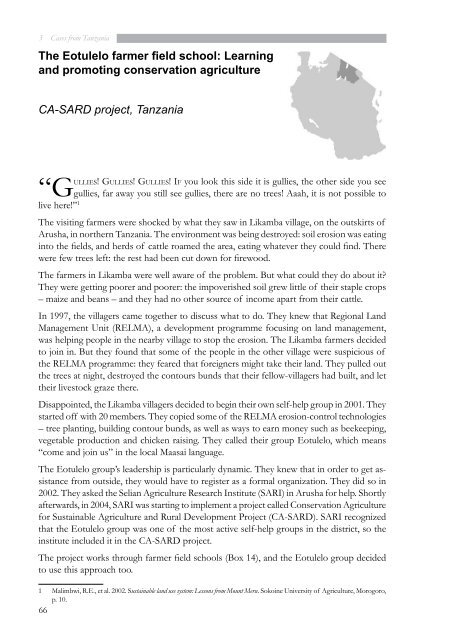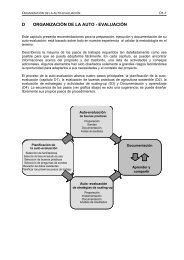cases from tanzania - Sustainet
cases from tanzania - Sustainet
cases from tanzania - Sustainet
Create successful ePaper yourself
Turn your PDF publications into a flip-book with our unique Google optimized e-Paper software.
3 Cases <strong>from</strong> Tanzania<br />
The Eotulelo farmer field school: Learning<br />
and promoting conservation agriculture<br />
CA-SARD project, Tanzania<br />
uLLies! GuLLies! GuLLies! iF you look this side it is gullies, the other side you see<br />
“Ggullies,<br />
far away you still see gullies, there are no trees! Aaah, it is not possible to<br />
live here!” 1<br />
The visiting farmers were shocked by what they saw in Likamba village, on the outskirts of<br />
Arusha, in northern Tanzania. The environment was being destroyed: soil erosion was eating<br />
into the fields, and herds of cattle roamed the area, eating whatever they could find. There<br />
were few trees left: the rest had been cut down for firewood.<br />
The farmers in Likamba were well aware of the problem. But what could they do about it?<br />
They were getting poorer and poorer: the impoverished soil grew little of their staple crops<br />
– maize and beans – and they had no other source of income apart <strong>from</strong> their cattle.<br />
In 1997, the villagers came together to discuss what to do. They knew that Regional Land<br />
Management Unit (RELMA), a development programme focusing on land management,<br />
was helping people in the nearby village to stop the erosion. The Likamba farmers decided<br />
to join in. But they found that some of the people in the other village were suspicious of<br />
the RELMA programme: they feared that foreigners might take their land. They pulled out<br />
the trees at night, destroyed the contours bunds that their fellow-villagers had built, and let<br />
their livestock graze there.<br />
Disappointed, the Likamba villagers decided to begin their own self-help group in 2001. They<br />
started off with 20 members. They copied some of the RELMA erosion-control technologies<br />
– tree planting, building contour bunds, as well as ways to earn money such as beekeeping,<br />
vegetable production and chicken raising. They called their group Eotulelo, which means<br />
“come and join us” in the local Maasai language.<br />
The Eotulelo group’s leadership is particularly dynamic. They knew that in order to get assistance<br />
<strong>from</strong> outside, they would have to register as a formal organization. They did so in<br />
2002. They asked the Selian Agriculture Research Institute (SARI) in Arusha for help. Shortly<br />
afterwards, in 2004, SARI was starting to implement a project called Conservation Agriculture<br />
for Sustainable Agriculture and Rural Development Project (CA-SARD). SARI recognized<br />
that the Eotulelo group was one of the most active self-help groups in the district, so the<br />
institute included it in the CA-SARD project.<br />
The project works through farmer field schools (Box 14), and the Eotulelo group decided<br />
to use this approach too.<br />
1 Malimbwi, R.E., et al. 2002. Sustainable land use system: Lessons <strong>from</strong> Mount Meru. Sokoine University of Agriculture, Morogoro,<br />
p. 10.<br />
66




